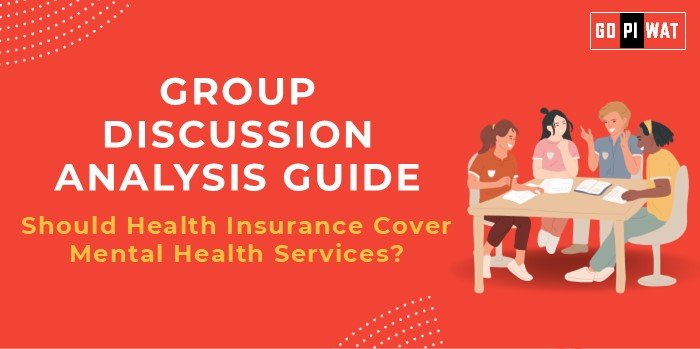📋 Group Discussion (GD) Analysis Guide: Should Health Insurance Cover Mental Health Services?
🌐 Introduction to the Topic
Opening Context: Mental health is increasingly recognized as a cornerstone of overall well-being. Globally, the economic and social costs of untreated mental health issues are staggering, making mental health services an integral component of healthcare.
Topic Background: The World Health Organization (WHO) highlights that depression and anxiety disorders cost the global economy $1 trillion annually in lost productivity. Despite its impact, mental health care is underfunded worldwide. In India, initiatives like the Mental Healthcare Act (2017) mandate the inclusion of mental health care within insurance coverage, but implementation remains inconsistent.
📊 Quick Facts and Key Statistics
– 💰 Economic Costs: Mental health disorders account for $16 trillion in cumulative economic output losses by 2030 (Lancet Commission).
– 🇮🇳 India’s Mental Health Budget: Only 1.3% of the health budget is allocated to mental health (Union Budget, 2024).
– 📉 Insurance Gap: Fewer than 15% of insurance policies in India offer comprehensive mental health coverage.
🤝 Stakeholders and Their Roles
- 🏛️ Government: Enforcing regulatory frameworks like the Mental Healthcare Act.
- 🏢 Private Insurers: Expanding mental health coverage and creating inclusive policies.
- 🏥 Healthcare Providers: Delivering accessible and affordable mental health services.
- 🧍 Citizens: Advocating for mental health parity.
- 🌍 International Organizations: WHO and UN providing guidelines and funding assistance.
🏆 Achievements and Challenges
✨ Achievements
- ✅ Legislative Progress: The Mental Healthcare Act mandates parity for mental health in insurance coverage.
- 📈 Increased Awareness: Mental health helplines saw a 40% increase in calls post-COVID-19, signaling reduced stigma.
- 🌍 Global Examples:
- 🇬🇧 UK: NHS provides comprehensive mental health services, funded through taxation.
- 🇦🇺 Australia: The “Better Access Initiative” integrates mental health into primary care.
⚠️ Challenges
- 🔍 Implementation Gaps: Insufficient inclusion in health insurance products.
- 🧠 Stigma: Persistent social stigma deters treatment-seeking.
- 📊 Resource Deficiency: India has only 0.75 psychiatrists per 100,000 people compared to WHO’s recommendation of 3.
💬 Structured Arguments for Discussion
Supporting Stance: “Covering mental health services under insurance ensures holistic health care and reduces societal costs of untreated mental disorders.”
Opposing Stance: “Integrating mental health into insurance risks premium hikes, making health care unaffordable for many.”
Balanced Perspective: “While coverage is essential for equity, phased implementation and stakeholder alignment are crucial to avoid unintended consequences.”
📚 Effective Discussion Approaches
- 📊 Opening Approaches:
- 📈 Fact-Based: “With mental health contributing to $16 trillion in global economic losses, the need for coverage is clear.”
- ⚖️ Contrast Approach: “In India, physical ailments are covered by insurance, yet mental health services are often excluded despite rising demand.”
- 🤝 Counter-Argument Handling:
- 💡 Rebuttal: “Premium increases are a valid concern, but cross-subsidization models can address this effectively.”
- ✅ Normalization: “Coverage itself can help normalize treatment-seeking behavior.”
🔍 Strategic Analysis of Strengths and Weaknesses
– ⚠️ Weaknesses: Implementation challenges, risk of premium escalation.
– 🌟 Opportunities: Public-private partnerships, tech-enabled mental health care.
– ⚠️ Threats: Stigma, lack of trained professionals.
📈 Connecting with B-School Applications
- 🌍 Real-World Applications:
- Potential B-school projects on designing sustainable mental health insurance models.
- Exploring behavioral economics to understand the stigma dynamics.
- ❓ Sample Interview Questions:
- 💬 “How would you balance affordability and inclusivity in mental health insurance?”
- 💡 “Discuss the role of mental health in corporate productivity.”
- 📖 Insights for B-School Students:
- Examine behavioral finance to design policies encouraging mental health treatment.
- Study global benchmarks like the NHS to propose scalable Indian solutions.


